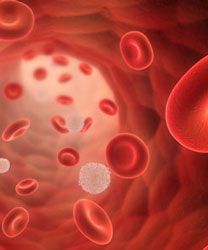Ibrutinib Associated With Superior QoL in MCL Compared With Temsirolimus
Phase III results from the RAY trial showed that patients with mantle cell lymphoma treated with ibrutinib (Imbruvica) had superior quality of life compared with patients treated with temsirolimus.
lymphoma

Phase III results from the RAY trial showed that patients with mantle cell lymphoma (MCL) treated with ibrutinib (Imbruvica) had superior quality of life (QoL) compared with patients treated with temsirolimus. The findings were published online in Leukemia & Lymphoma.
Patients assigned to ibrutinib experienced greater improvement from baseline in their symptoms and lymphoma-specific concerns, and had superior health-related quality of life. The findings are based on patient-reported outcomes from the Functional Assessment of Cancer Therapy-Lymphoma (FACTLym), which includes the FACT-G plus FACT-LymS subscale, and the EQ-5D-5L questionnaires assessing symptoms, well-being, health status, and health-related quality of life of patients on treatment.
On the FACTLym subscale, 62% of patients on ibrutinib compared with 36% of patients on temsirolimus had at least a 5-point change from baseline. Two-thirds of ibrutinib patients experienced a clinically meaningful improvement of at least 5 points in FACTLym total score.
Patients assigned to ibrutinib saw an improvement in the EQ-5D-5L utility values compared with baseline at all time-points up to cycle 17, which researchers said indicates a general improvement in the health-related quality of life. In contrast, patients in the temsirolimus arm experienced negative changes compared with baseline at all-time points.
FACT-G assesses general well-being while the FACTLymS measures the specific concerns of patients with lymphoma. EQ-5D-5L includes a 5-item questionnaire—mobility, self-care, usual activity, pain/discomfort, anxiety/depression—and a visual analog scale (VAS) to determine general well-being.
“The results presented here suggest that ibrutinib reduces symptoms, and maintains and restores well-being, health status, and health-related quality of life among relapsed/refractory MCL patients,” wrote Hess et al. “Incorporating the patient’s subjective experience and perspective into clinical trial outcomes can provide an important complement to clinical endpoints and provide additional information for both clinicians and patients to consider when assessing the risk—benefit balance of treatments.”
The RAY trial was a phase III, randomized, open-label, multicenter study comparing ibrutinib (n = 139) with temsirolimus (n = 141) in patients with relapsed/refractory MCL who had received one or more prior rituximab-containing therapies. Ibrutinib was associated with a statistically significant 57% reduction in disease progression or death (hazard ratio [HR], 0.43; 95% CI, 0.32-0.58; P <.0001).
Ibrutinib was better tolerated than temsirolimus, with a superior adverse event (AE) profile despite a longer duration of exposure (14.4 months vs 3.0 months).
Researchers collected FACTLym and EQ-5D-5L responses from patients with MCL at the beginning of clinic visits prior to any procedures or physician interactions. Questionnaires were administered on day 1 of every cycle during the first 6 months, then every 9 weeks up to 15 months after the first dose of study drug. After that point, researchers collected patient-reported outcomes every 24 weeks.
The FACT-Lym was administered until disease progression, death, or clinical cutoff, and the EQ-5D-5L was administered until study end, death, or clinical cutoff. Following disease progression, researchers administered the EQ-5D-5L every 9 weeks, up to 3 times, during the survival follow-up period, unless death, study end, or clinical cutoff occurred first. For patients who received ibrutinib after crossing over from temsirolimus, the questionnaires were collected until discontinuation of ibrutinib.
Overall, 94% of patients assigned to ibrutinib and 87% of those assigned to temsirolimus provided FACTLym responses at baseline.
The mean differences in FACT-LymS subscale, FACT-PWB, and Trial Outcome Index scores were significantly different between treatment arms through at least 11 cycles of treatment, a sign that ibrutinib patients experienced greater improvement from baseline for both general well-being and lymphoma-specific concerns.
The Trial Outcome Index is a summary index, calculated from the FACT-G physical well-being domain (FACT-PWB), the functional well-being domain (FACT-FWB), and the FACT-LymS subscale.
Per the 5Q-5D-5L VAS evaluation, patients on ibrutinib reported an improvement in their general well-being compared with a worsening well-being for those assigned to temsirolimus. Changes for ibrutinib from baseline for VAS values were positive and statistically different from temsirolimus at all-time points before cycle 20. In contrast, VAS changes from baseline for temsirolimus were negative at all time points. Patients receiving temsirolimus had consistently lower utility and VAS values from baseline.
Researchers found that EQ-5D-5L values did not return to baseline levels in the temsirolimus group, and were consistently lower than those in the ibrutinib group at any time point up to cycle 14.
Hess G, Rule S, Jurczak W, et al. Health-related quality of life data from a phase 3, international, randomized, open-label, multicenter study in patients with previously treated mantle cell lymphoma treated with ibrutinib versus temsirolimus [published online May 30, 2017]. Leuk Lymphoma. doi: 10.1080/10428194.2017.1326034.



